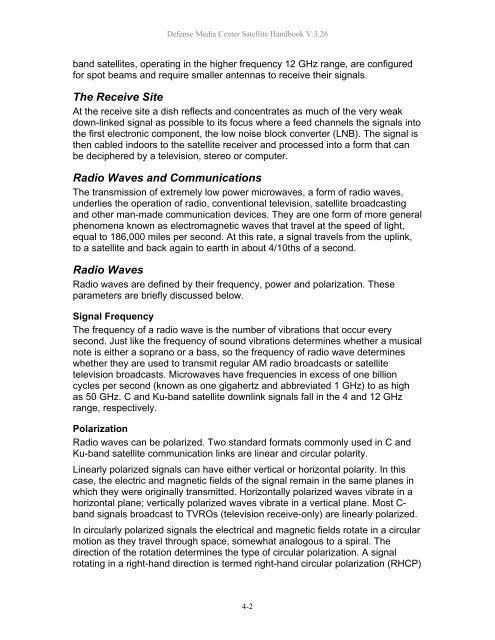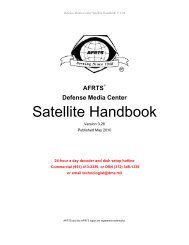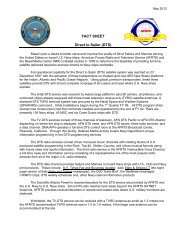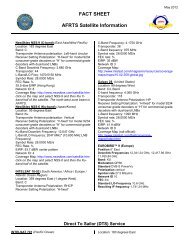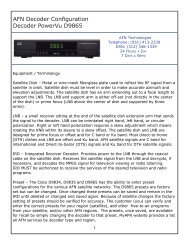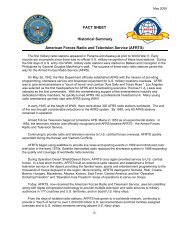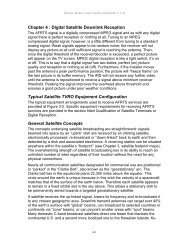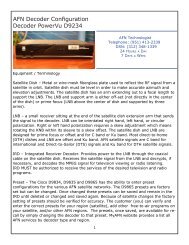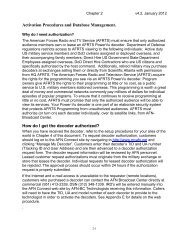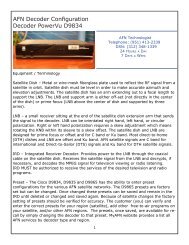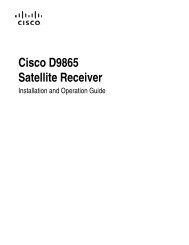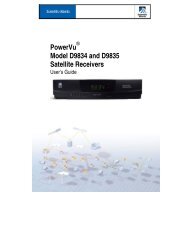AFRTS Defense Media Center Satellite Handbook
AFRTS Defense Media Center Satellite Handbook
AFRTS Defense Media Center Satellite Handbook
You also want an ePaper? Increase the reach of your titles
YUMPU automatically turns print PDFs into web optimized ePapers that Google loves.
<strong>Defense</strong> <strong>Media</strong> <strong>Center</strong> <strong>Satellite</strong> <strong>Handbook</strong> V.3.26<br />
band satellites, operating in the higher frequency 12 GHz range, are configured<br />
for spot beams and require smaller antennas to receive their signals.<br />
The Receive Site<br />
At the receive site a dish reflects and concentrates as much of the very weak<br />
down-linked signal as possible to its focus where a feed channels the signals into<br />
the first electronic component, the low noise block converter (LNB). The signal is<br />
then cabled indoors to the satellite receiver and processed into a form that can<br />
be deciphered by a television, stereo or computer.<br />
Radio Waves and Communications<br />
The transmission of extremely low power microwaves, a form of radio waves,<br />
underlies the operation of radio, conventional television, satellite broadcasting<br />
and other man-made communication devices. They are one form of more general<br />
phenomena known as electromagnetic waves that travel at the speed of light,<br />
equal to 186,000 miles per second. At this rate, a signal travels from the uplink,<br />
to a satellite and back again to earth in about 4/10ths of a second.<br />
Radio Waves<br />
Radio waves are defined by their frequency, power and polarization. These<br />
parameters are briefly discussed below.<br />
Signal Frequency<br />
The frequency of a radio wave is the number of vibrations that occur every<br />
second. Just like the frequency of sound vibrations determines whether a musical<br />
note is either a soprano or a bass, so the frequency of radio wave determines<br />
whether they are used to transmit regular AM radio broadcasts or satellite<br />
television broadcasts. Microwaves have frequencies in excess of one billion<br />
cycles per second (known as one gigahertz and abbreviated 1 GHz) to as high<br />
as 50 GHz. C and Ku-band satellite downlink signals fall in the 4 and 12 GHz<br />
range, respectively.<br />
Polarization<br />
Radio waves can be polarized. Two standard formats commonly used in C and<br />
Ku-band satellite communication links are linear and circular polarity.<br />
Linearly polarized signals can have either vertical or horizontal polarity. In this<br />
case, the electric and magnetic fields of the signal remain in the same planes in<br />
which they were originally transmitted. Horizontally polarized waves vibrate in a<br />
horizontal plane; vertically polarized waves vibrate in a vertical plane. Most Cband<br />
signals broadcast to TVROs (television receive-only) are linearly polarized.<br />
In circularly polarized signals the electrical and magnetic fields rotate in a circular<br />
motion as they travel through space, somewhat analogous to a spiral. The<br />
direction of the rotation determines the type of circular polarization. A signal<br />
rotating in a right-hand direction is termed right-hand circular polarization (RHCP)<br />
4-2


